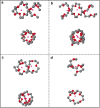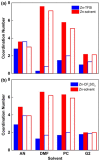Elucidating Solvation Structures for Rational Design of Multivalent Electrolytes-A Review
- PMID: 29700688
- PMCID: PMC5920006
- DOI: 10.1007/s41061-018-0195-2
Elucidating Solvation Structures for Rational Design of Multivalent Electrolytes-A Review
Abstract
Fundamental molecular-level understanding of functional properties of liquid solutions provides an important basis for designing optimized electrolytes for numerous applications. In particular, exhaustive knowledge of solvation structure, stability, and transport properties is critical for developing stable electrolytes for fast-charging and high-energy-density next-generation energy storage systems. Accordingly, there is growing interest in the rational design of electrolytes for beyond lithium-ion systems by tuning the molecular-level interactions of solvate species present in the electrolytes. Here we present a review of the solvation structure of multivalent electrolytes and its impact on the electrochemical performance of these batteries. A direct correlation between solvate species present in the solution and macroscopic properties of electrolytes is sparse for multivalent electrolytes and contradictory results have been reported in the literature. This review aims to illustrate the current understanding, compare results, and highlight future needs and directions to enable the deep understanding needed for the rational design of improved multivalent electrolytes.
Keywords: Multivalent electrolytes; Renewable energy; Solvation structure.
Figures


















References
-
- Xu K. Nonaqueous liquid electrolytes for lithium-based rechargeable batteries. Chem Rev. 2004;104(10):4303–4418. - PubMed
-
- Gonzalez F (2016) Advanced and post lithium-ion batteries 2016-2026: technologies, markets, Forecasts 2016, Retrieved fromhttp://www.idtechex.com/
-
- Li Q, Bjerrum NJ. Aluminum as anode for energy storage and conversion: a review. J Power Sources. 2002;110(1):1–10.
-
- Lin M-C, Gong M, Lu B, Wu Y, Wang D-Y, Guan M, Angell M, Chen C, Yang J, Hwang B-J, Dai H. An ultrafast rechargeable aluminium-ion battery. Nature. 2015;520(7547):324–328. - PubMed
-
- Gregory TD, Hoffman RJ, Winterton RC. Nonaqueous electrochemistry of magnesium applications to energy storage. J Electrochem Soc. 1990;137(3):775–780.
Publication types
Grants and funding
LinkOut - more resources
Full Text Sources
Other Literature Sources
